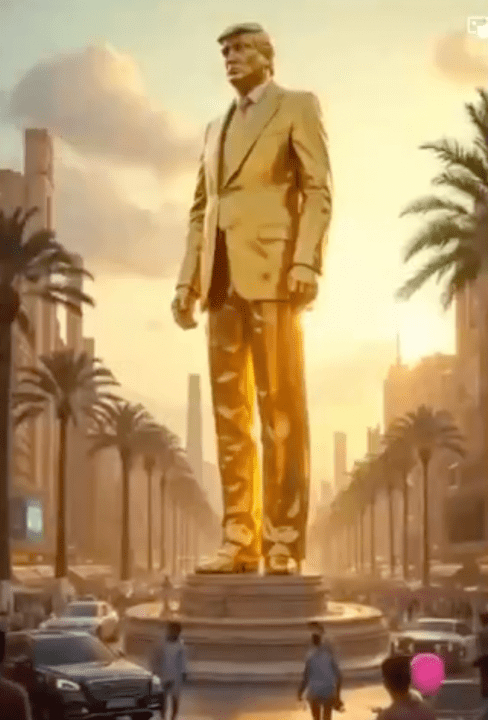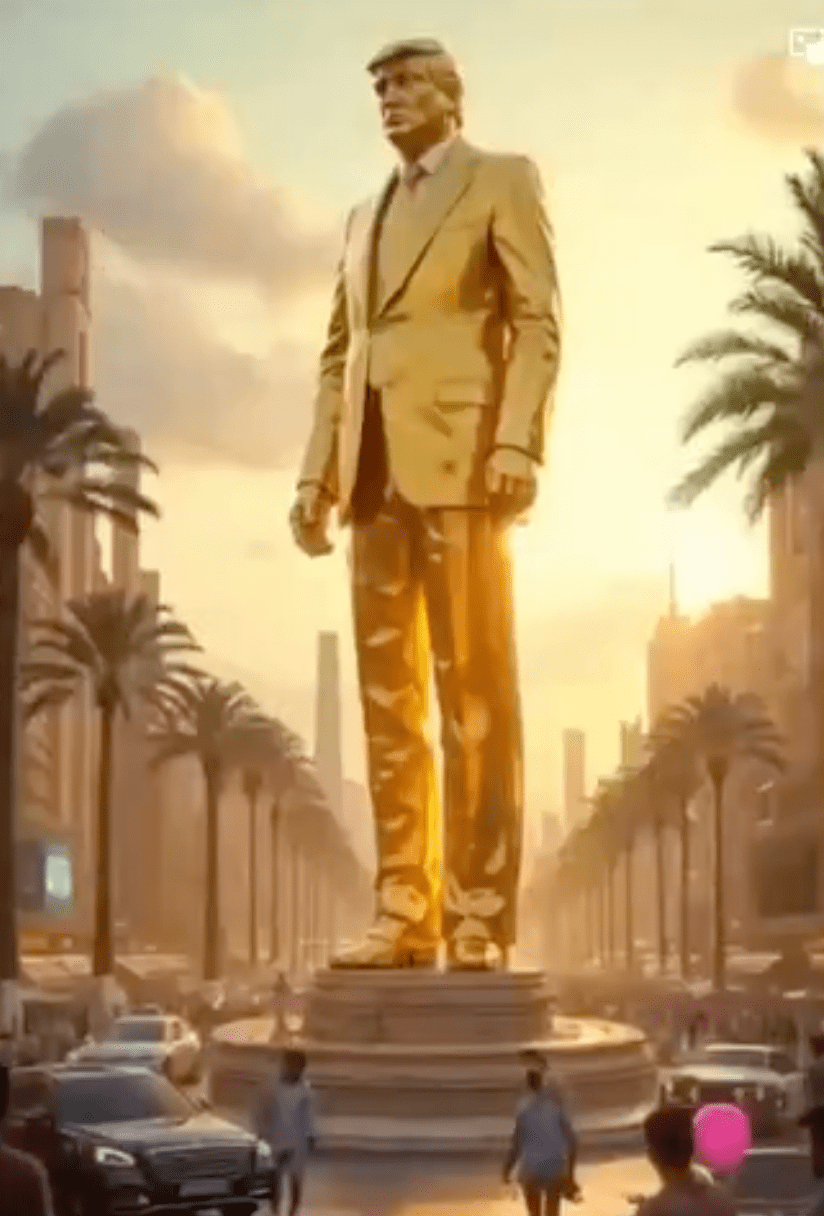Donald Trump’s AI-generated vision of Gaza – complete with golden statues of himself, bearded belly dancers, and a triumphant song declaring, ‘Trump Gaza, number one!’ – landed like a slap across the face of polite Western discourse. The reactions were swift and predictable. Outraged commentators called it tasteless, delusional, the fever dream of a man obsessed with his own mythology. Newspapers mocked its crudeness, its cartoonish spectacle, its lack of realism.
Yet, in all the ridicule, something crucial was missed. This wasn’t just Trump being Trump. This was Trump speaking Arabic again – not linguistically, but in the deeply symbolic, visually driven language of Middle Eastern power. The video was not a policy document. It was not a peace proposal. It was an assertion, a piece of brash visual propaganda in the same spirit as the region’s own power plays – where images speak louder than statements, and dominance is declared not through words, but through spectacle.
Trump’s video was not a policy proposal but a fantasy of submission
Nowhere is this language more evident than in the carefully orchestrated prisoner handovers that have become a central theatre in the Israeli-Palestinian conflict. The recent Hamas release of Israeli hostages was a performance as much as it was a negotiation outcome. Every detail was designed for maximum symbolic impact and dread.
As captives were handed over, the cameras rolled, ensuring that the world would see Hamas fighters standing tall and armed, while the released Israelis – disoriented, thin, reduced – shuffled forward under the approving gaze of their captors. To a Western audience, it was a grim, distressing scene. To the Arab world, it was a message of control. Hamas was not merely releasing hostages; they were granting freedom, positioning themselves as both warriors and benevolent victors.
Israel understood this all too well. Its response was immediate and just as calculated. When Palestinian prisoners were released in exchange, they were made to wear white t-shirts emblazoned with Arabic text: ‘We never forget, we never forgive.’ The message was not just for the prisoners – it was for the entire Arab world: we are not finished with you.
The prisoners, sensing the insult, tried to reclaim the words by scrawling them on the walls of their cells before leaving. But Israeli guards filmed the prisoners as they were forced to paint over their own graffiti, broadcasting the footage as a final act of dominance. Even their resistance was erased. Even their defiance was controlled.
Nowhere was the visual politics of humiliation more explicit than in the forced kiss – a moment that, in the West, was seen as one of coerced gratitude but, in the Middle East, carried a far deeper significance. Israeli hostage Omer Shem Tov, upon his release, was forced to kiss the heads of the Hamas terrorists who had tortured and imprisoned him, before being allowed to leave. The cameras caught it, and the footage spread across pro-Palestinian networks as proof of Hamas’ kindness. See how well they treated their prisoners? See how grateful he is? But that framing was false. The video clearly shows the hostage being given an order. This was no kiss of thanks. It was a kiss of forced submission.
Israeli Arab communications expert Idit Bar immediately recognised the historical weight of the moment, recalling the Islamic story of Safiyya bint Huyayy, the Jewish woman taken captive after the Muslim conquest of Khaybar in 628. Her father and husband were slaughtered and Muhammad made her his tenth wife – her conversion to Islam and submission to him presented as an act of love rather than one of obvious compulsion. Today, at anti-Israel protests in Western cities, ‘Khaybar, Khaybar, ya Yahud’ – a chilling reference to that massacre – is regularly chanted as a threat to Jews. The symbolism endures. The forced kiss was a re-enactment of an ancient ritual: the conqueror demands an act of loving submission, the vanquished performs it under duress.
The death of a leader is also provides ample opportunity for symbolism. The recent funeral extravaganza for Hezbollah’s assassinated leader Hassan Nasrallah was not merely a mourning ritual. It was a spectacle, a declaration of both loss and continuity. The Iranians poured $44 million (£35 million) into his elaborate tomb complex – because Nasrallah had been their most effective general, and his death had to be mythologised.
As Bar noted, the Shiite narrative was set: His body did not decay. His scent remained sweet even five months after his death. He was a martyr, a saint. Crowds gathered to seek his blessing. Mourners threw scarves and kufis toward the coffin, where Hezbollah fighters rubbed them against Nasrallah’s black turban before hurling them back. The baraka of the fallen leader, redistributed among the faithful. This was not simply grief – it was a public reaffirmation of Hezbollah’s power.
Israel responded in kind with its own clear symbolism: as Nasrallah’s mourners chanted, Israeli Air Force jets thundered overhead, flying low over the procession. A bold message, written in sound: The Shiite axis is dead. We are not. It was a symbol of ‘never again’.
This is the world Trump’s AI video was playing into. It may have looked absurd to Westerners, but it was never meant for them. It was a vision of dominance – Gaza remade in his image, with skyscrapers, yachts, and his name in gold. It was not a policy proposal but a fantasy of submission. His critics saw delusion, but in the Middle East, where power is also asserted through symbolism, he was speaking their language.
This was just posted on President Trump’s Truth Social account. pic.twitter.com/9zrVcBGjK1
— Yashar Ali 🐘 (@yashar) February 26, 2025









Comments